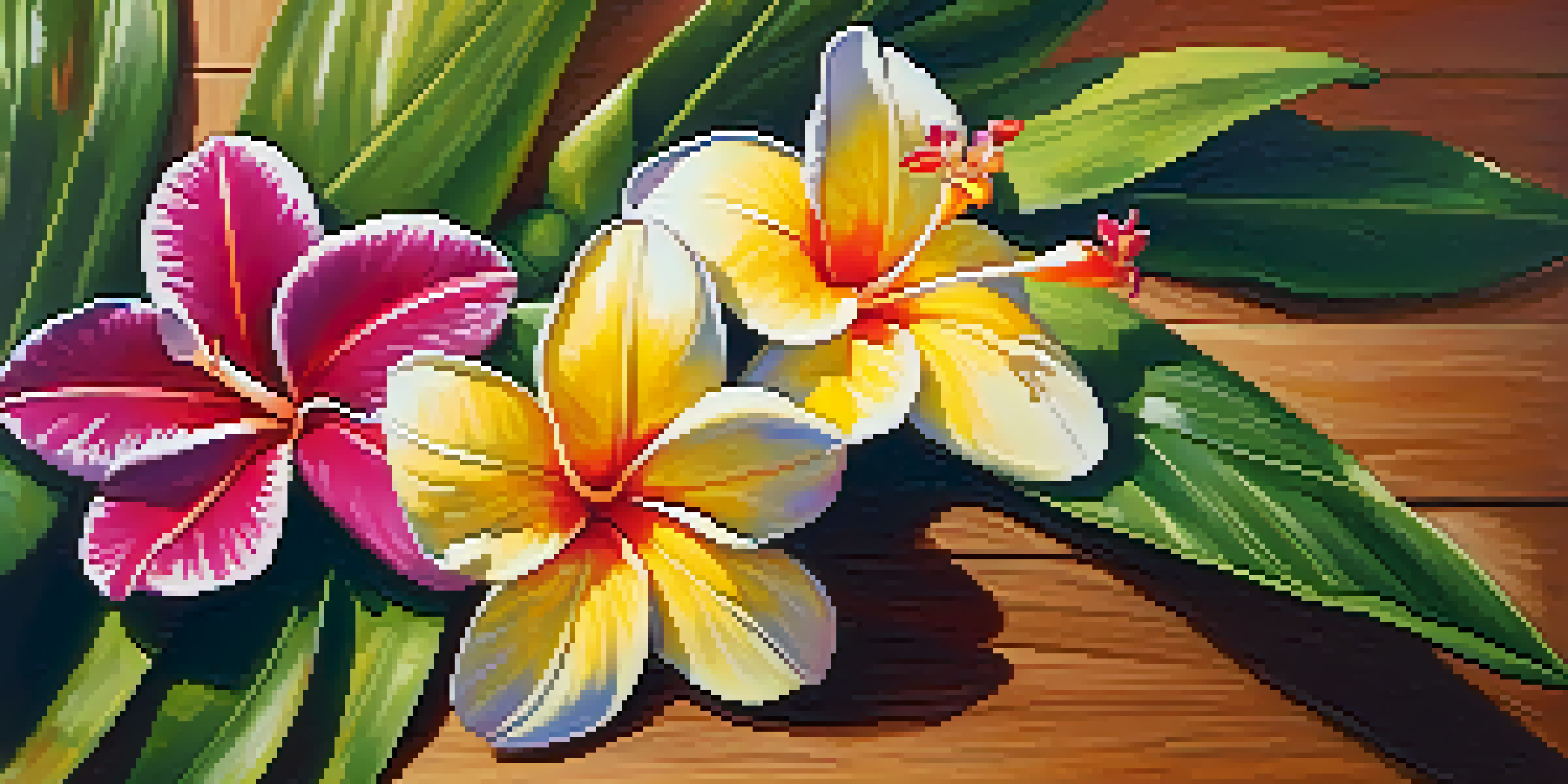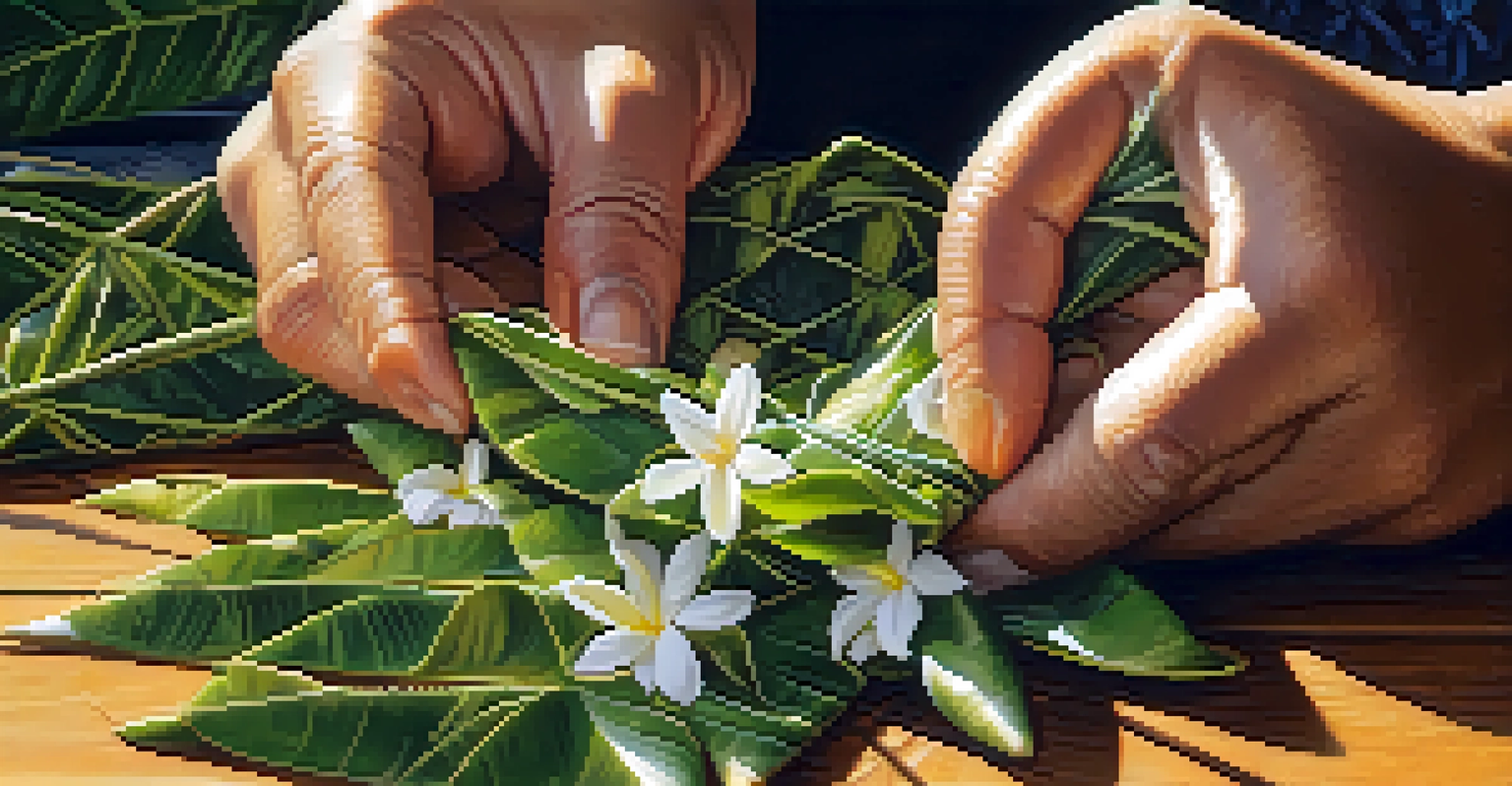The Significance of Lei in Hawaiian Culture and Traditions

Understanding the Symbolism of Lei in Hawaiian Culture
In Hawaiian culture, a lei is much more than just a beautiful garland; it symbolizes love, friendship, and respect. Traditionally made from flowers, leaves, or shells, lei are gifted during special occasions, embodying the spirit of aloha. This gesture signifies connection and appreciation, making the act of giving and receiving a lei deeply meaningful.
A lei is not just a garland; it is a heartfelt expression of connection that resonates with people near and far.
The significance of a lei can vary depending on the materials used and the context of its presentation. For instance, a lei made from bright flowers may represent joy and celebration, while one crafted from maile leaves can symbolize peace and unity. Each lei tells a story, capturing emotions and memories that resonate with both the giver and the recipient.
Moreover, wearing a lei is often seen as a sign of honor. During events such as graduations, weddings, or luaus, participants don lei to celebrate achievements and milestones together. This practice reinforces community bonds and reinforces the values of respect and love that are central to Hawaiian life.
The Cultural Significance of Lei Making
Lei making is an art form passed down through generations, reflecting the creativity and resourcefulness of the Hawaiian people. Traditionally, this craft involved using natural materials found on the islands, instilling a sense of connection to the land and its resources. Each handmade lei is a labor of love, often taking hours to create, which adds to its sentimental value.

The process of making a lei can also serve as a communal activity, bringing families and friends together to share stories and laughter. During these gatherings, individuals learn about the cultural practices and the meanings behind different flowers and plants. This not only preserves the tradition but also strengthens interpersonal relationships within the community.
Lei Represents Aloha and Connection
In Hawaiian culture, lei symbolize love, friendship, and respect, embodying the spirit of aloha through meaningful gifting.
Additionally, lei making has evolved into a form of cultural expression, where artisans showcase their skills and creativity. Workshops and festivals celebrate this craft, allowing both locals and visitors to engage with Hawaiian culture. By learning to make a lei, participants gain a deeper appreciation for the heritage and the symbolism embedded within this cherished tradition.
Lei in Hawaiian Ceremonies and Celebrations
Lei play a vital role in various Hawaiian ceremonies, marking important life events and cultural practices. For instance, during weddings, couples often exchange lei as a sign of their commitment to each other, symbolizing the intertwining of their lives. Similarly, lei are prevalent during graduations, where they honor the accomplishments of graduates and signify new beginnings.
The act of giving a lei is imbued with meaning, as it signals the beginning of a relationship between the host and the guest.
Festivals like Aloha Festivals celebrate Hawaiian culture through parades and events that prominently feature lei. Participants wear colorful lei, showcasing the diversity of Hawaiian flora and the creativity of lei makers. These celebrations serve not only as entertainment but also as a means to educate people about Hawaiian traditions and the importance of community.
In addition to these events, lei are used in memorials and funerals as a way to honor loved ones who have passed. The act of placing a lei on a grave or a memorial site signifies respect and remembrance. This poignant use of lei highlights their versatility and deep emotional resonance in various aspects of life.
The Role of Lei in Hawaiian Hospitality
In Hawaiian culture, hospitality is paramount, and lei are often used as a warm welcome for visitors. Upon arrival, guests are typically greeted with a lei, symbolizing the spirit of aloha and the islanders' desire to share their culture. This gesture is more than just a traditional practice; it reflects a genuine commitment to making guests feel valued and appreciated.
The act of giving a lei is imbued with meaning, as it signals the beginning of a relationship between the host and the guest. It fosters a sense of connection, encouraging visitors to embrace the beauty and richness of Hawaiian culture. This welcoming tradition creates lasting memories and encourages a spirit of reciprocity and respect.
Lei Making is a Cultural Tradition
The art of lei making fosters community bonds and serves as a communal activity that preserves Hawaiian cultural practices.
Furthermore, lei are often exchanged during community gatherings and events, reinforcing hospitality within neighborhoods. Whether at luaus or cultural festivals, the sharing of lei cultivates a sense of camaraderie and belonging, enabling people to come together to celebrate their shared heritage.
The Connection Between Lei and Nature
The materials used in lei making highlight the deep connection Hawaiians have with nature. Traditional lei are crafted from local plants and flowers, celebrating the unique biodiversity of the islands. This relationship emphasizes the importance of sustainability and respecting the environment, values that are integral to Hawaiian culture.
For instance, flowers such as plumeria and orchids are popular choices for lei, each carrying its own significance and symbolism. By using native plants, lei makers not only showcase their artistic skills but also promote ecological awareness. This connection to nature enriches the cultural narrative and inspires a sense of stewardship for the land.
Moreover, many communities engage in sustainable practices by cultivating their own gardens to source materials for lei making. This not only helps preserve native plant species but also fosters a deeper appreciation for the environment. Through this connection, the act of creating and gifting lei becomes a celebration of both culture and nature.
Modern Interpretations and Global Influence of Lei
While lei have deep roots in Hawaiian culture, their influence has expanded globally, often seen as a symbol of love and celebration in various contexts. Today, you'll find lei being used in different cultures, often as a decorative element or a gift in celebrations. This broader recognition helps to spread awareness of Hawaiian traditions and the values they represent.
In modern times, artists and artisans have begun experimenting with unconventional materials, incorporating beads, ribbons, and even recycled items into lei making. This innovation reflects the evolving nature of culture, where traditional practices blend with contemporary creativity. Such adaptations not only keep the tradition alive but also attract new generations to engage with it.
Lei in Ceremonies and Hospitality
Lei play a vital role in celebrations and ceremonies, symbolizing important life events and showcasing the islanders' hospitality.
Moreover, the global popularity of Hawaiian tourism has introduced many people to the beauty of lei, often leading to a newfound appreciation for Hawaiian culture. Visitors leave the islands with memories of receiving or wearing a lei, creating a lasting connection to Hawaii. This intersection of tradition and modernity showcases the resilience and adaptability of cultural practices.
Conclusion: The Enduring Legacy of Lei in Hawaiian Culture
The lei is a powerful symbol of love, respect, and connection within Hawaiian culture, encapsulating the essence of aloha. Its significance transcends mere decoration, serving as a reminder of the values that bind individuals and communities together. From ceremonies to daily life, lei continue to play an integral role in celebrating relationships and honoring traditions.
As society evolves, the practice of lei making and gifting adapts while still holding onto its core meanings. The enduring legacy of lei reflects the resilience of Hawaiian culture, as it embraces both tradition and innovation. This dynamic nature ensures that the spirit of aloha remains vibrant and relevant for future generations.

Ultimately, the lei is not just a garland; it is a heartfelt expression of connection that resonates with people near and far. By understanding and appreciating its significance, we can celebrate the rich tapestry of Hawaiian culture and participate in keeping these cherished traditions alive.